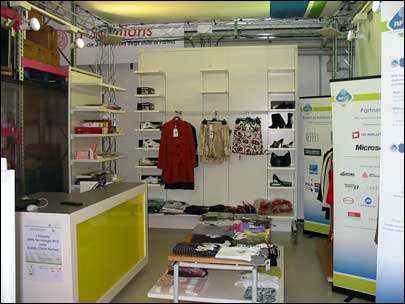Apr 24, 2009After testing a business case that uses RFID in 15 logistical and in-store processes in a replicated fashion retail store and distribution center (DC), the University of Parma's RFID Lab has determined that it could take as little as three years to achieve a positive return on investment (ROI). The calculated payback was based on an estimated time-savings of approximately 80 percent for RFID-based processes compared with manual processes, as well as higher sales revenue due to reduced stock-outs.
The replicated fashion retail store and DC were built at the Parma lab as a separate, related project to serve as a demonstration environment for testing RFID in fashion retail. The business-case test, which launched in June 2008 (see Italian RFID Lab Gets Fashion-Forward) and ended in December 2008, was overseen by the lab's Fashion Board of Advisors, a committee of 13 companies that includes Dolce & Gabbana and IMAX—Max Mara Fashion Group. The board is led by Roberto Montanari, a University of Parma professor who directed the test, which focused on processes starting at the end of the manufacturing line for fashion articles, and ending with the flow of returned goods. The project employed case- and pallet-level tagging, and the business case was based on item-level tagging scenarios, says Antonio Rizzi, the RFID Lab's director and a full professor of industrial logistics and supply chain management at the university's department of industrial engineering.
The project's partners worked together in three phases, the first of which involved research into retailers' existing logistical processes—an "as is" analysis. In this phase, researchers examined eight processes in six DCs, and seven processes at five retail stores. The second phase focused on developing new scenarios utilizing EPC Gen 2-based RFID technology to optimize processes. Specifically, the partners designed RFID hardware and software infrastructure around RFID-based processes.
The researchers designed and tested various RFID-based processes, such as picking and shipping at the DC, as well as receiving, inventory, anti-theft measures, marketing and customer service at the retail store. The processes work with software designed and integrated by Id-Solutions, a University of Parma spin-off, and based on Microsoft BizTalk RFID, and hardware from various technology partners for the project. ADT provided an RFID smart shelf that can identify tagged clothing items, in addition to an anti-theft system that integrates traditional magneto-acoustic technology with RFID. Jamison Doors' Industrial Portals division provided a Gnome RFID portal, which was used to develop an antitheft gate. Mojix installed its system, consisting of a STAR receiver and six eNodes which cover the entire area of the RFID Fashion Store for managing inventory and locating items in real time using passive RFID tags.
Tracient Technologies provided its Padl-R UHF RFID handheld RFID interrogator to perform manual tag reads, while Avery Dennison, Lab ID and UPM Raflatac supplied the RFID inlays and tags used to identify clothing items within the RFID Fashion Store. Label Store Industries and SML provided a set of tags (composition labels, cardboard tags and fabric labels) specifically developed for use in the textile industry.
"The important thing is that the system already knows what's in the box," Rizzi says. "It can cross-check the RFID reads with what is expected, based on information gathered from the previous process."
The test of the various processes includes the use of the EPC network. Data is available on the DC's EPC server. When the store receives the box, an EPC network query is made to receive relevant data regarding the shipping or manufacturing process.
The third phase of the project involved creating a calculation model for assessing the economic feasibility of the RFID-based processes. Using the model, the researchers evaluated what they considered to be a representative supply chain, with one DC and 20 retail stores and an annual product flow of approximately 7.8 million items.
The test assumed that the manufacturer tagged individual items at the end of the production line. A best-case scenario resulted in an investment of €1.37 million ($1.81 million) in RFID hardware and software, and yielded a positive ROI within three years. A worst-case scenario required an investment of €1.59 million ($2.11 million), necessary to outfit a supply chain that had little existing technology in use, and yielded a positive ROI within three years. In both scenarios, approximately 20 to 25 percent of the investments were needed for the DC, while the rest was required for the retail stores. A major component of these calculations was the cost of tags needed for one year—roughly €656,000 ($869,000), using an average of .08 cents per tag.



